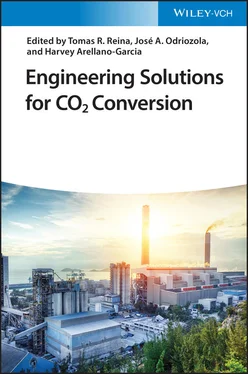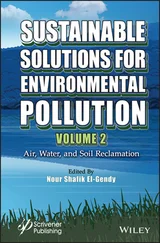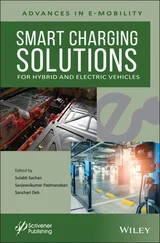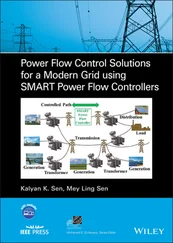22 22 Abu‐Zahra, M.R.M., Sodiq, A., and Feron, P.H.M. (2016). Commercial Liquid Absorbent‐Based PCC Processes. Elsevier Ltd.
23 23 Xu, Z., Wang, S., Zhao, B., and Chen, C. (2013). Study on potential biphasic solvents: absorption capacity, CO2 loading and reaction rate. Energy Procedia 37: 494–498.
24 24 Gladis, A., Gundersen, M.T., Fosbøl, P.L. et al. (2017). Influence of temperature and solvent concentration on the kinetics of the enzyme carbonic anhydrase in carbon capture technology. Chem. Eng. J. 309: 772–786.
25 25 Aines, R.D., Spaddaccini, C.M., Duoss, E.B. et al. (2013). Encapsulated solvents for carbon dioxide capture. Energy Procedia 37: 219–224.
26 26 Zheng, D.‐Q., Ma, W.‐D., Wei, R., and Guo, T.‐M. (1999). Solubility study of methane, carbon dioxide and nitrogen in ethylene glycol at elevated temperatures and pressures. Fluid Phase Equilib. 155 (2): 277–286.
27 27 The DOW Chemical Company (2015). The DOW Chemical Company Product Safety Assessment SELEXOL TM Solvents. pp. 1–5.
28 28 Takahashi, S., Song, K.Y., and Kobayashi, R. (1984). Experimental vapor‐liquid equilibriums in the carbon dioxide‐diethylene glycol‐water and carbon dioxide‐triethylene glycol‐water systems at feasible absorption temperatures and pressures. J. Chem. Eng. Data 29 (1): 23–28.
29 29 Jou, F.‐Y., Otto, F.D., and Mather, A.E. (2000). Solubility of H2S and CO2 in diethylene glycol at elevated pressures. Fluid Phase Equilib. 175: 53–61.
30 30 Lin, H., Wu, T., and Lee, M. (2003). Isothermal vapor – liquid equilibria for binary mixtures of carbon dioxide with diethylene glycol (diethyl, butyl, hexyl, or dibutyl) ether at elevated pressures. Fluid Phase Equilib. 209: 131–145.
31 31 Henni, A., Tontiwachwuthikul, P., and Chakma, A. (2008). Solubilities of carbon dioxide in polyethylene glycol ethers. Can. J. Chem. Eng. 83 (2): 358–361.
32 32 Garcia, M., Knuutila, H.K., Aronu, U.E., and Gu, S. (2018). Influence of substitution of water by organic solvents in amine solutions on absorption of CO2. Int. J. Greenhouse Gas Control 78: 286–305.
33 33 Guo, C., Chen, S., Zhang, Y., and Wang, G. (2014). Solubility of CO2 in nonaqueous absorption system of 2‐(2‐aminoethylamine)ethanol + benzyl alcohol. J. Chem. Eng. Data 59: 1796–1801.
34 34 Yuan, Y. and Rochelle, G.T. (2019). Lost work: a comparison of water‐lean solvent to a second generation aqueous amine process for CO2 capture. Int. J. Greenhouse Gas Control 84: 82–90.
35 35 Le Moullec, Y., Neveux, T., Al Azki, A. et al. (2014). Process modifications for solvent‐based post‐combustion CO2 capture. Int. J. Greenhouse Gas Control 31: 96–112.
36 36 Bhattacharyya, D. and Miller, D.C. (2017). Post‐combustion CO2 capture technologies – a review of processes for solvent‐based and sorbent‐based CO2 capture. Curr. Opin. Chem. Eng. 17: 78–92.
37 37 Rochelle, G.T., Wu, Y., Chen, E. et al. (2019). Pilot plant demonstration of piperazine with the advanced flash stripper. Int. J. Greenhouse Gas Control 84: 72–81.
38 38 Song, C., Liu, Q., Ji, N. et al. (2018). Alternative pathways for efficient CO2 capture by hybrid processes – a review. Renewable Sustainable Energy Rev. 82: 215–231.
39 39 EG&G Technical Services, Inc (2004). Fuel Cell Handbook, 7e). US‐DOE NETL Under Contract No. DE‐AM26‐99FT40575.
40 40 Adams, T.A., Nease, J., Tucker, D., and Barton, P.I. (2013). Energy conversion with solid oxide fuel cell systems: a review of concepts and outlooks for the short‐ and long‐term. Ind. Eng. Chem. Res. 52 (9): 3089–3111.
41 41 Amrollahi, Z., Ystad, P.A.M., Ertesvåg, I.S., and Bolland, O. (2012). Optimized process configurations of post‐combustion CO2 capture for natural‐gas‐fired power plant – power plant efficiency analysis. Int. J. Greenhouse Gas Control 8: 1–11.
42 42 Bolland, O. (2010). Thermal Power Generation, 32. NTNU.
43 43 Adams, T. and Mac Dowell, N. (2016). Off‐design point modelling of a 420 MW CCGT power plant integrated with an amine‐based post‐combustion CO2 capture and compression process. Appl. Energy 178: 681–702.
44 44 Jordal, K., Ystad, P.A.M., Anantharaman, R. et al. (2012). Design‐point and part‐load considerations for natural gas combined cycle plants with post combustion capture. Int. J. Greenhouse Gas Control 11: 271–282.
45 45 Lucquiaud, M., Chalmers, H., and Gibbins, J. (2009). Capture‐ready supercritical coal‐fired power plants and flexible post‐combustion CO2 capture. Energy Procedia 1 (1): 1411–1418.
46 46 Pan, M., Aziz, F., Li, B. et al. (2016). Application of optimal design methodologies in retrofitting natural gas combined cycle power plants with CO2 capture. Appl. Energy 161: 695–706.
47 47 Karimi, M., Hillestad, M., and Svendsen, H.F. (2011). Capital costs and energy considerations of different alternative stripper configurations for post combustion CO2 capture. Chem. Eng. Res. Des. 89 (8): 1229–1236.
48 48 Diego, M.E., Bellas, J.‐M., and Pourkashanian, M. (2017). Process analysis of selective exhaust gas recirculation for CO2 capture in natural gas combined cycle power plants using amines. J. Eng. Gas Turbines Power 139 (12): 121701.
49 49 Gonzalez Díaz, A., Sanchez, E., Gonzalez Santalób, J.M. et al. (2014). On the integration of sequential supplementary firing in natural gas combined cycle for CO2‐enhanced oil recovery: a technoeconomic analysis for Mexico. Energy Procedia 63: 7558–7567.
50 50 Jonshagen, K., Sipöcz, N., and Genrup, M. (2010). A novel approach of retrofitting a combined cycle with post combustion CO2 capture. J. Eng. Gas Turbines Power 133 (1): 011703.
51 51 IEAGHG (2012). Operating Flexibility of Power Plants with CCS.
52 52 Brouwer, A.S., van den Broek, M., Seebregts, A., and Faaij, A. (2015). Operational flexibility and economics of power plants in future low‐carbon power systems. Appl. Energy 156: 107–128.
53 53 Johnsson, F., Odenberger, M., and Göransson, L. (2014). Challenges to integrate CCS into low carbon electricity markets. Energy Procedia 63: 7485–7493.
54 54 Gonzalez‐Salazar, M.A., Kirsten, T., and Prchlik, L. (2018). Review of the operational flexibility and emissions of gas‐ and coal‐fired power plants in a future with growing renewables. Renewable Sustainable Energy Rev. 82: 1497–1513.
55 55 Montañés, R.M., Korpås, M., Nord, L.O., and Jaehnert, S. (2016). Identifying operational requirements for flexible CCS power plant in future energy systems. Energy Procedia 86 (1876): 22–31.
56 56 Rezazadeh, F., Gale, W.F., Akram, M. et al. (2016). Performance evaluation and optimisation of post combustion CO2 capture processes for natural gas applications at pilot scale via a verified rate‐based model. Int. J. Greenhouse Gas Control 53: 243–253.
57 57 Hauger, S.O., Flø, N.E., Kvamsdal, H. et al. (2019). Demonstration of non‐linear model predictive control of post‐combustion CO2 capture processes. Comput. Chem. Eng. 123: 184–195.
58 58 Lawal, A., Wang, M., Stephenson, P., and Obi, O. (2012). Demonstrating full‐scale post‐combustion CO2 capture for coal‐fired power plants through dynamic modelling and simulation. Fuel 101: 115–128.
59 59 Montañés, R.M., GarÐarsdóttir, S., Normann, F. et al. (2017). Demonstrating load‐change transient performance of a commercial‐scale natural gas combined cycle power plant with post‐combustion CO2 capture. Int. J. Greenhouse Gas Control 63: 158–174.
60 60 Gardarsdóttir, S., Montañés, R.M., Normann, F. et al. (2017). Effects of CO2‐absorption control strategies on the dynamic performance of a supercritical pulverized‐coal‐fired power plant. Ind. Eng. Chem. Res. 56 (15): 4415–4430.
61 61 Bui, M., Gunawan, I., Verheyen, V. et al. (2016). Flexible operation of CSIRO's post‐combustion CO2 capture pilot plant at the AGL Loy Yang power station. Int. J. Greenhouse Gas Control 48: 188–203.
Читать дальше












